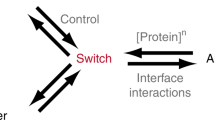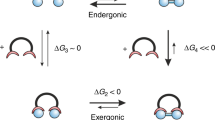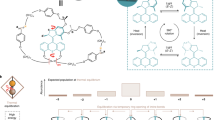Abstract
Natural protein assemblies have many sophisticated architectures and functions, creating nanoscale storage containers, motors and pumps1,2,3. Inspired by these systems, protein monomers have been engineered to self-assemble into supramolecular architectures4 including symmetrical5,6, metal-templated7,8 and cage-like structures8,9,10. The complexity of protein machines, however, has made it difficult to create assemblies with both defined structures and controllable functions. Here we report protein assemblies that have been engineered to function as light-controlled nanocontainers. We show that an adenosine-5′-triphosphate-driven group II chaperonin11,12, which resembles a barrel with a built-in lid, can be reprogrammed to open and close on illumination with different wavelengths of light. By engineering photoswitchable azobenzene-based molecules into the structure, light-triggered changes in interatomic distances in the azobenzene moiety are able to drive large-scale conformational changes of the protein assembly. The different states of the assembly can be visualized with single-particle cryo-electron microscopy, and the nanocages can be used to capture and release non-native cargos. Similar strategies that switch atomic distances with light could be used to build other controllable nanoscale machines.
This is a preview of subscription content, access via your institution
Access options
Subscribe to this journal
Receive 12 print issues and online access
$259.00 per year
only $21.58 per issue
Buy this article
- Purchase on Springer Link
- Instant access to full article PDF
Prices may be subject to local taxes which are calculated during checkout



Similar content being viewed by others
References
Tanaka, S. et al. Atomic-level models of the bacterial carboxysome shell. Science 319, 1083–1086 (2008).
Vale, R. D. The molecular motor toolbox for intracellular transport. Cell 112, 467–480 (2003).
Forgac, M. Vacuolar ATPases: rotary proton pumps in physiology and pathophysiology. Nature Rev. Mol. Cell Biol. 8, 917–929 (2007).
Yeates, T. O. & Padilla, J. E. Designing supramolecular protein assemblies. Curr. Opin. Struct. Biol. 12, 464–470 (2002).
King, N. P. et al. Computational design of self-assembling protein nanomaterials with atomic level accuracy. Science 336, 1171–1174 (2012).
Gradisar, H. et al. Design of a single-chain polypeptide tetrahedron assembled from coiled-coil segments. Nature Chem. Biol. 9, 362–366 (2013).
Brodin, J. D. et al. Metal-directed, chemically tunable assembly of one-, two- and three-dimensional crystalline protein arrays. Nature Chem. 4, 375–382 (2012).
Huard, D. J., Kane, K. M. & Tezcan, F. A. Re-engineering protein interfaces yields copper-inducible ferritin cage assembly. Nature Chem. Biol. 9, 169–176 (2013).
Fletcher, J. M. et al. Self-assembling cages from coiled-coil peptide modules. Science 340, 595–599 (2013).
Lai, Y. T., Cascio, D. & Yeates, T. O. Structure of a 16-nm cage designed by using protein oligomers. Science 336, 1129 (2012).
Kusmierczyk, A. R. & Martin, J. Nucleotide-dependent protein folding in the type II chaperonin from the mesophilic archaeon Methanococcus maripaludis. Biochem. J. 371, 669–673 (2003).
Zhang, J. et al. Mechanism of folding chamber closure in a group II chaperonin. Nature 463, 379–383 (2010).
Pereira, J. H. et al. Crystal structures of a group II chaperonin reveal the open and closed states associated with the protein folding cycle. J. Biol. Chem. 285, 27958–27966 (2010).
Kumita, J. R., Smart, O. S. & Woolley, G. A. Photo-control of helix content in a short peptide. Proc. Natl Acad. Sci. USA 97, 3803–3808 (2000).
Schierling, B. et al. Controlling the enzymatic activity of a restriction enzyme by light. Proc. Natl Acad. Sci. USA 107, 1361–1366 (2010).
Banghart, M., Borges, K., Isacoff, E., Trauner, D. & Kramer, R. H. Light-activated ion channels for remote control of neuronal firing. Nature Neurosci. 7, 1381–1386 (2004).
Muramatsu, S., Kinbara, K., Taguchi, H., Ishii, N. & Aida, T. Semibiological molecular machine with an implemented ‘AND’ logic gate for regulation of protein folding. J. Am. Chem. Soc. 128, 3764–3769 (2006).
Umeki, N. et al. Incorporation of an azobenzene derivative into the energy transducing site of skeletal muscle myosin results in photo-induced conformational changes. J. Biochem. 136, 839–846 (2004).
Beharry, A. A. et al. Quantitative analysis of the effects of photoswitchable distance constraints on the structure of a globular protein. Biochemistry 51, 6421–6431 (2012).
Douglas, N. R. et al. Dual action of ATP hydrolysis couples lid closure to substrate release into the group II chaperonin chamber. Cell 144, 240–252 (2011).
Jiang, Y. et al. Sensing cooperativity in ATP hydrolysis for single multisubunit enzymes in solution. Proc. Natl Acad. Sci. USA 108, 16962–16967 (2011).
Behrendt, R. et al. Photomodulation of the conformation of cyclic peptides with azobenzene moieties in the peptide backbone. Angew. Chem. Int. Ed. 38, 2771–2774 (1999).
Reissmann, S. et al. A gradient of ATP affinities generates an asymmetric power stroke driving the chaperonin TRIC/CCT folding cycle. Cell Rep. 2, 866–877 (2012).
Ishii, D. et al. Chaperonin-mediated stabilization and ATP-triggered release of semiconductor nanoparticles. Nature 423, 628–632 (2003).
Biswas, S. et al. Biomolecular robotics for chemomechanically driven guest delivery fuelled by intracellular ATP. Nature Chem. 5, 613–620 (2013).
Dimaio, F., Zhang, J., Chiu, W. & Baker, D. Cryo-EM model validation using independent map reconstructions. Protein Sci. 22, 865–868 (2013).
Schneider, C. A., Rasband, W. S. & Eliceiri, K. W. NIH Image to ImageJ: 25 years of image analysis. Nature Methods 9, 671–675 (2012).
Ludtke, S. J., Nason, L., Tu, H., Peng, L. & Chiu, W. Object oriented database and electronic notebook for transmission electron microscopy. Microsc. Microanal. 9, 556–565 (2003).
Tang, G. et al. EMAN2: an extensible image processing suite for electron microscopy. J. Struct. Biol. 157, 38–46 (2007).
Chen, D. H., Song, J. L., Chuang, D. T., Chiu, W. & Ludtke, S. J. An expanded conformation of single-ring GroEL–GroES complex encapsulates an 86 kDa substrate. Structure 14, 1711–1722 (2006).
Scheres, S. H. W. & Chen, S. Prevention of overfitting in cryo-EM structure determination. Nature Methods 9, 853–854 (2012).
Rosenthal, P. B. & Henderson, R. Optimal determination of particle orientation, absolute hand, and contrast loss in single-particle electron cryomicroscopy. J. Mol. Biol. 333, 721–745 (2003).
Pettersen, E. F. et al. UCSF Chimera—a visualization system for exploratory research and analysis. J. Comput. Chem. 25, 1605–1612 (2004).
Acknowledgements
The authors thank J. Frydman and N. Douglas for discussions and advice throughout this work and for sharing the Mm-cpn plasmid, A. Woolley for discussions and a gift of ABDM, S.J. Ludtke for advice on image processing and J. Fraser for comments on the manuscript. This research was supported by grants from the Program for Breakthrough Biomedical Research and the Sandler Family Foundation (to T.K.), the National Institutes of Health (PN2EY016525 and P41GM103832 to W.C.), the National Science Foundation (NSF CBET-1134127 to T.K.) and a Deutsche Forschungsgemeinschaft postdoctoral fellowship (HO 4429/2-1 to D.H.).
Author information
Authors and Affiliations
Contributions
T.K. and D.H. designed the research. D.H. performed the computational design, biochemical experiments and model building. S-H.R. performed the cryo-electron microscopy experiments. S-H.R. and W.C. analysed the cryo-electron microscopy data. All authors wrote the manuscript.
Corresponding author
Ethics declarations
Competing interests
The authors declare no competing financial interests.
Supplementary information
Supplementary information
Supplementary Information (PDF 2447 kb)
Rights and permissions
About this article
Cite this article
Hoersch, D., Roh, SH., Chiu, W. et al. Reprogramming an ATP-driven protein machine into a light-gated nanocage. Nature Nanotech 8, 928–932 (2013). https://doi.org/10.1038/nnano.2013.242
Received:
Accepted:
Published:
Issue Date:
DOI: https://doi.org/10.1038/nnano.2013.242
This article is cited by
-
Bioinspired nanochannels based on polymeric membranes
Science China Materials (2021)
-
Assembly of a patchy protein into variable 2D lattices via tunable multiscale interactions
Nature Communications (2020)
-
REP-X: An Evolution-guided Strategy for the Rational Design of Cysteine-less Protein Variants
Scientific Reports (2020)
-
Engineering protein assemblies with allosteric control via monomer fold-switching
Nature Communications (2019)
-
A light-driven three-dimensional plasmonic nanosystem that translates molecular motion into reversible chiroptical function
Nature Communications (2016)



